Japan's proud national sport, sumo, has more to it than just putting two large, semi-naked people in a ring and have them try to push each other, they say.
"People think it's so easy, but they should try it and see for themselves how difficult it is," Kotooshu, the first European to ever proceed to the second-highest rank of sumo in Japan, explained.
Kotooshu incorporated the techniques particular to sumo in his Western wrestling skills. Within three years and two months, the Bulgarian native climbed the ladder to the second-highest rank of ozeki in Japan.
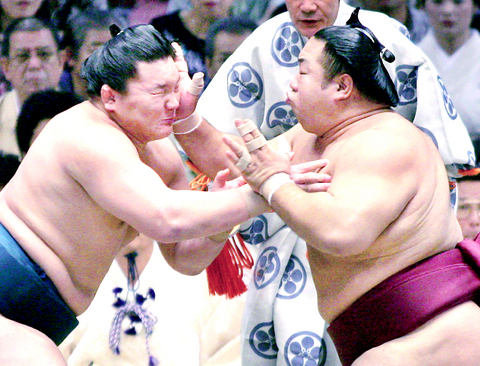
PHOTO: AFP
But Kotooshu was shocked to see conventional discipline dominating Japan's national sport in the 21st century. He expected to train with state-of-the-art equipment, he said.
"`What in the world is this?' was honestly my first impression," the wrestler said in Japanese after routine training one morning. "You can get arrested for doing that [caning] in other countries."
About 30 large, naked men in their beige loin cloths stood and observed a lower rank member tackling his practice partner head-on during the training.
Before breakfast at around 6am, the members come down from their dormitory rooms to the practice ground with a ring made of rope.
It's a sacred place where they are engulfed with energy. Not even whispers are heard. The only noises are loud panting, wheezing of the wrestlers' lungs and occasional caning on their legs.
Cued by the stable master and trainers mumbling in their rough voices, senior wrestlers would slap or blow water on a junior member being trained.
Kotooshu was no exception. He says he was caned on his thigh three times before he became ozeki. He couldn't protest because of his language ability.
But he believed that endurance makes perfect and built up his strength.
When Japan's national sport was risking a loss in popularity, foreign wrestlers like Kotooshu joined the industry and appeared on TV, saving sumo from retreating into the background.
As the number of non-Japanese sumo began to rise in 2000, the sport has regained its fame and fans. And Kotooshu has contributed to the boost in popularity.
The ozeki, born as Kaloyan Stefanov Mahlyanov, stands tall at 2.03m and slim at 147kg, unlike classic sumo wrestlers whose stomach extends out and thighs sag.
The young Bulgarian wrestler was scouted by a sumo federation in his home country before traveling half way around the world.
Nicknamed "Gentle Giant," Kotooshu likes to sleep in, go out for dinners and to movies with friends on his days off.
But the man who loves sports and chose sumo as his life's vocation wants to spread the fascination of sumo around the world.
Sumo is barely keeping its quota with the entry of foreign nationals into the field, because very few Japanese young people show interest in it.
Currently, Mongolian athletes are in the majority among 12 non-Japanese nationalities.
Although the Sumo Association limits its 54 stables to accepting one foreign national, Kotooshu thinks the game needs more promotion abroad and can appeal to the world as an international sport just like judo.
just one win
Grand champion Asashoryu was only one win away from the championship yesterday, defeating Kaio to stay in sole lead at the Nagoya Grand Sumo tournament.
In the day's final bout at Aichi Prefectural Gymnasium, Mongolia-born Asashoryu quickly got a firm hold on the ozeki's belt to shove him out of the ring and into the stands.
Asashoryu's record improved to 13-0 -- one win away from clenching the championship -- while Kaio fell to 8-5.
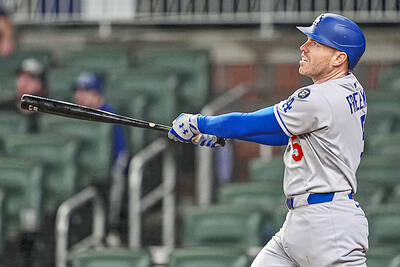
Freddie Freeman homered and drove in four runs, Shohei Ohtani also went deep and Roki Sasaki earned his first major league win as the Los Angeles Dodgers beat the Atlanta Braves 10-3 on Saturday night for their seventh straight victory. The Dodgers have won the first two games of the series to improve to 5-0 against Atlanta this year. Los Angeles’ three-game sweep at home early in the season left the Braves 0-7. Sasaki allowed three runs and six hits over five innings. The 23-year-old right-hander gave up a home run to Ozzie Albies, but received plenty of offensive support in his
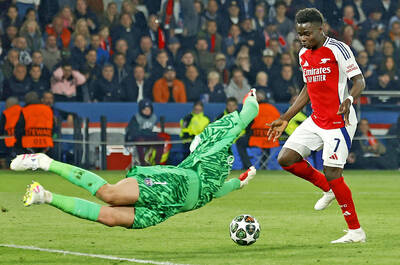
INTER AWAIT: Superb saves by PSG ’keeper Gianluigi Donnarumma inspired the victory, as Arsenal were punished for misses, including one by Bukayo Saka Arsenal on Wednesday fell short on the big stage again as their painful UEFA Champions League semi-final exit against Paris Saint-Germain left Mikel Arteta to rue his club’s failure to provide him with enough attacking options. Arteta’s side were unable to reach the Champions League final for the first time in 19 years as PSG clinched a tense 2-1 win at Parc des Princes. Trailing 1-0 from last week’s first leg in London, the Gunners made a blistering start to the second leg, but could not convert their chances as Gianluigi Donnarumma’s superb saves inspired PSG’s 3-1 aggregate victory. Arsenal were punished for
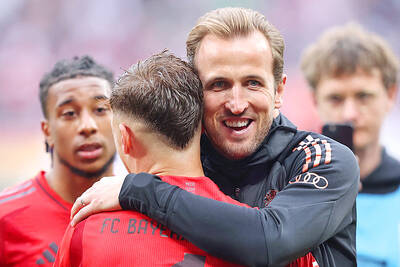
Bayern Munich on Sunday were crowned German champions for the 34th time, giving striker Harry Kane his first major trophy, after second-placed Bayer 04 Leverkusen drew 2-2 at SC Freiburg. Bayern’s 3-3 draw at RB Leipzig on Saturday, when the Bavarians came from two goals down to take the lead before conceding a stoppage-time equalizer, meant defending Bundesliga champions Leverkusen needed to win at Freiburg to delay the title party. Leverkusen were two goals down before scoring twice in the final 10 minutes, but Xabi Alonso’s side could not find a third, as Bayern reclaimed the title at the first attempt after
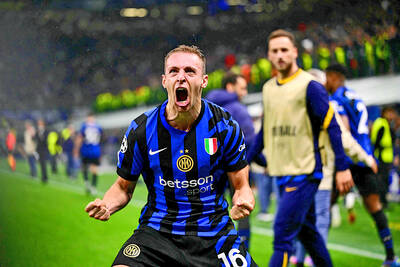
THRILLER: Raphinha gave Barca a 3-2 lead with two minutes remaining of regular time, but Francesco Acerbi equalized the game in the second minute of added time Davide Frattesi on Tuesday fired Inter into the UEFA Champions League final with an extra-time winner that gave the Italians a stunning 4-3 triumph over Barcelona, 7-6 on aggregate. Italy midfielder Frattesi won a tie for the ages under a downpour in Milan when he lashed home in the 99th minute, sending a packed and rocking San Siro wild with joy. Simone Inzaghi’s team will face either Arsenal or Paris Saint-Germain at the end of this month in Munich, Germany, where they would feel they have a great chance to be crowned kings of Europe for a fourth time after